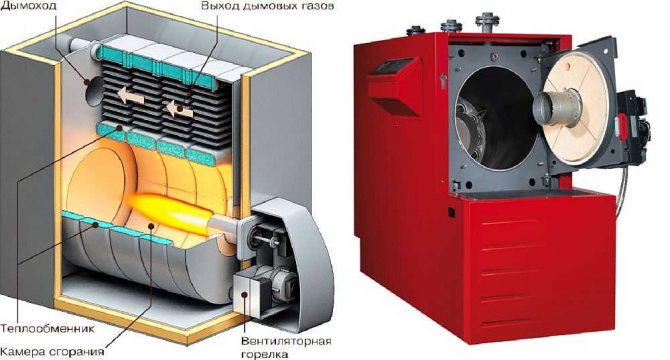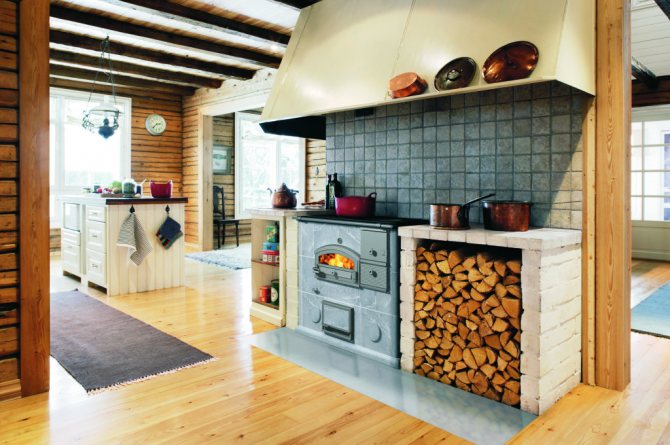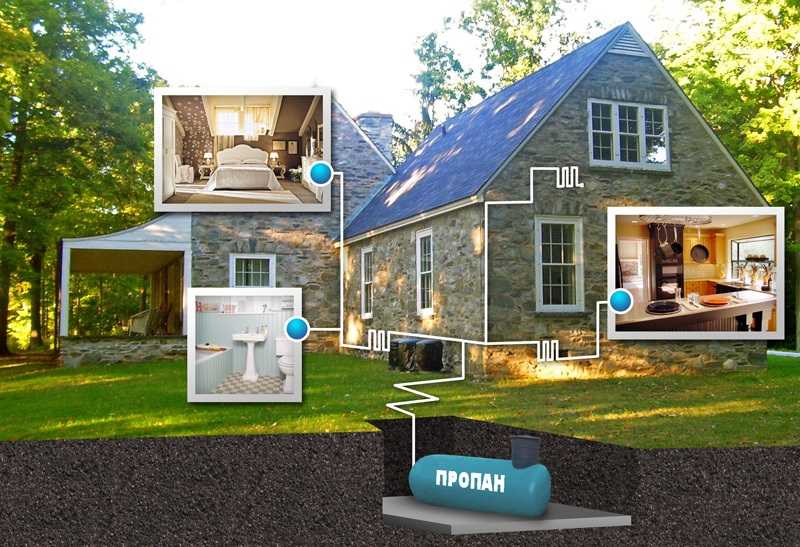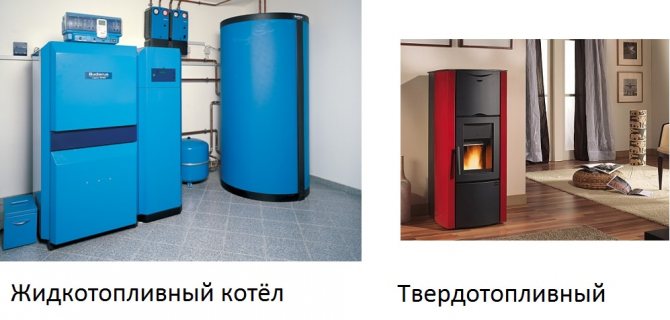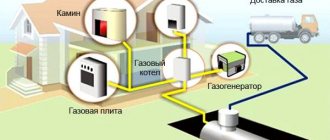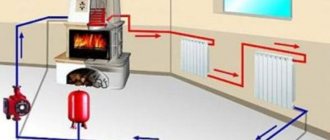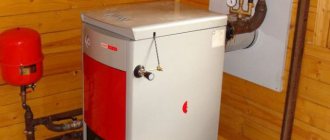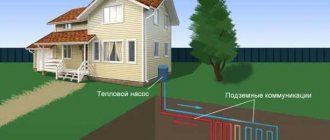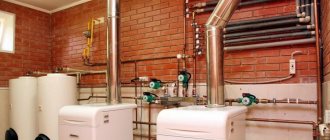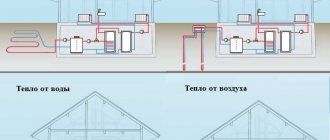Every owner of a private house thinks about how to heat a house without electricity and gas. Since these services are quite expensive, everyone wants to save money and at the same time provide their homes with heat.
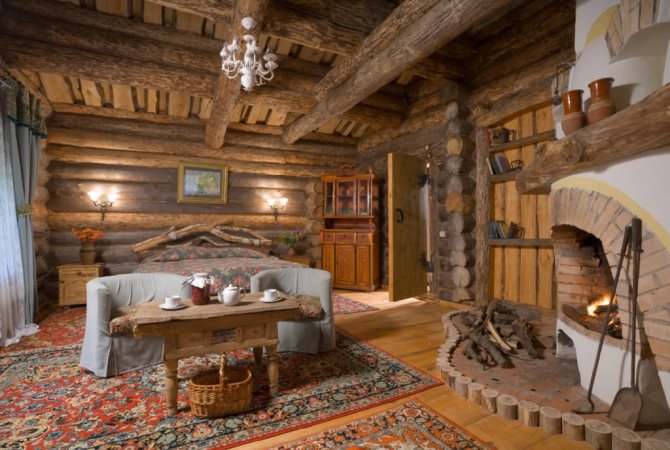
Among the options for heating a house without electricity and gas are the following:
- Water heating (the main component of the boiler is connected to pipes that are located throughout the house).
- Solid fuel heating (such heating is carried out with the help of wood. Boilers are installed, which reduce fuel consumption, as well as the production of harmful substances).
Solid fuel boilers
Solid fuel is used not only in large boiler houses, but also in small boilers for heating private houses. In addition to coal, solid fuel boilers use firewood and pellets, straw, sawdust and chips.
Pellet properties:
- Low cost;
- Ease of transportation;
- Environmental friendliness.
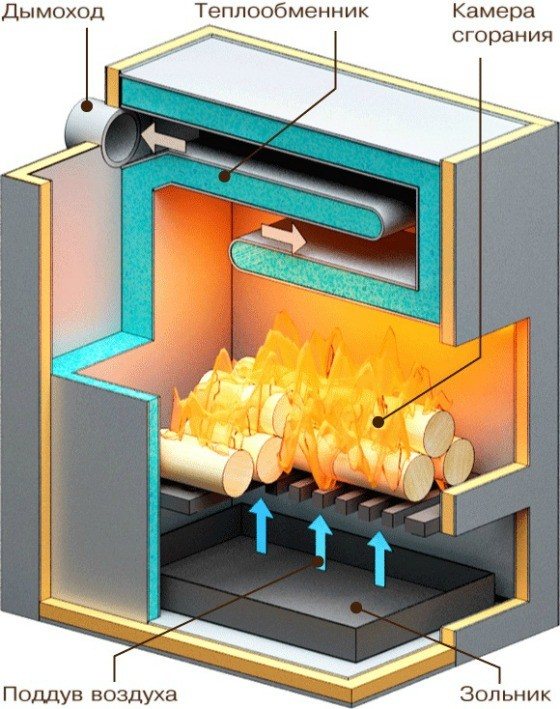

Sectional diagram of a solid fuel boiler
Operating principle
It is similar to traditional equipment: fuel is burned in the furnace, due to which the coolant is heated.
Benefits:
- High efficiency;
- Safety;
- Compactness (modern models).
The disadvantage is the complexity of servicing this system: frequent loading of fuel, regular cleaning of the combustion chamber, etc. Modern models are equipped with an automatic fuel supply system, which makes this type of alternative heating the main competitor for gas boilers.
Advantages and disadvantages
Coal stove
The advantages of coal and wood stoves include the following:
- Using coal in areas where it can be mined in large quantities will not cost a lot of money.
- Coal burns long and clean, compared to other materials.
- Wood burning stoves are efficient when installed them together with the air exhaust system.
- Such furnaces are designed without a screw. and any other electromechanical devices.
- Regular use of such stoves will reduce the cost of heating your home.
- The coal stove is a backup heating system, which will allow you to heat the house in the event of a power failure or lack of gas.
As for the disadvantages of such ovens, they can be as follows:
- The fire hazard of such structures is at a high level.
- Not every home has a place to store a large amount of firewood and coal.
- Such ovens do not have an automatic feeding system, so they must not be left unattended.
- The presence of coal is not found in every region.
Oil fired boilers
They use fuel oil or diesel fuel as fuel.
Benefits:
- High efficiency;
- Possibility of installing additional equipment (boilers) into the system without reconstructing existing circuits;
- Effective heating of large rooms;
- High reliability of installations;
- Fast installation;
- Compactness (modern models).
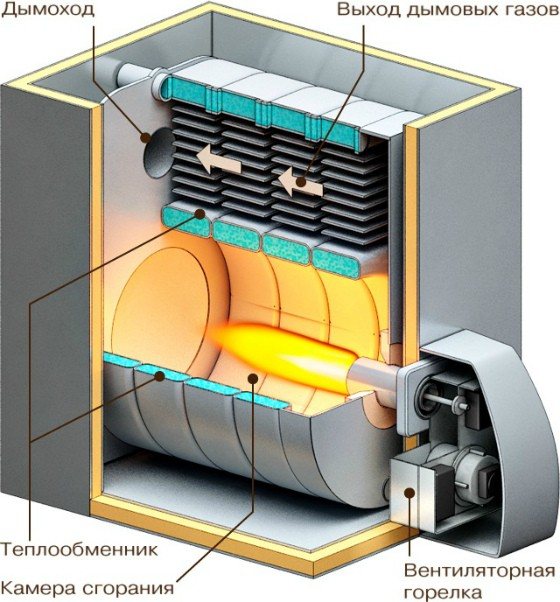

Sectional diagram of a diesel boiler
The disadvantages of this type of heating include:
- Presence of harmful emissions into the atmosphere;
- Installation of additional instrumentation and control devices (for continuous monitoring of network parameters);
- The need for a separate room for the boiler;
- Difficulties in the transportation and storage of liquid fuels.
Forehead to forehead
The economy must be economical
Since our goal is to save on heating costs, let's start by assessing the cost-effectiveness of alternative heat sources. We will compare the cost of a kilowatt-hour of thermal energy obtained in different ways.
| Heat source | Price per kilowatt-hour of thermal energy, rub |
| Main natural gas | 0,5 |
| Dry firewood | 0,9 |
| Pellets (granular sawdust) | 1,4 |
| Coal | 1,6 |
| Liquefied gas in cylinders | 2,8 |
| Diesel fuel | 3,2 |
| Electricity (direct heating) | 3,8 |
Everything is simple and clear: if there is no gas, the cheapest type of fuel is firewood. Other solid fuels lag behind by a small gap. Electric heating is an outsider.
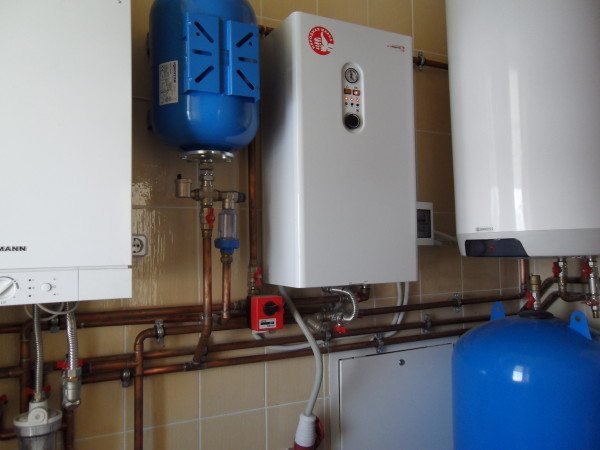

An electric boiler is a source of the most expensive heat.
Laziness was born before me
However, the assessment of a particular heat source does not end with its economic efficiency. It is also important for us how convenient it is to use the corresponding heating system: it should be as autonomous as possible, not requiring constant maintenance.
For this parameter, a completely different sequence emerges:
- The undisputed leader is electricity heating. All types of electric heating do not require the owner's attention, provide unlimited autonomy (the house can be heated indefinitely in the absence of residents) and do not need to remove combustion products;
- The honorable second place in the absence of gas equipment goes to the diesel boiler. It is also capable of operating without maintenance until it runs out of fuel. In the shortcomings of heating on diesel fuel, we will write down the accompanying odors, the noise of the burner (a diesel boiler requires a separate boiler room) and the need to store several hundred, or even thousands of liters of fuel;
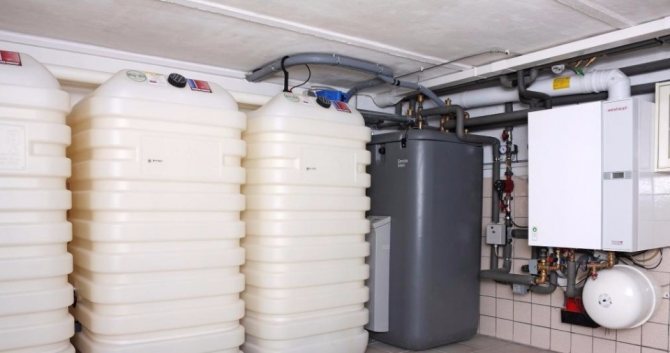

The stock of diesel fuel is stored in the boiler room and, frankly, it does not ozonize the air.
- The third place is given to the pellet boiler. The bunker for fuel and the automatic system of its dosage provide autonomy up to one week;
- The gas cylinder will have to be changed and taken to refueling once a day. By connecting several cylinders in parallel, you can get an autonomy of 5 - 7 days;
- Firewood and coal are trailing behind. A solid fuel boiler requires cleaning the ash pan, filling the fuel and cleaning the ash pan every few hours.
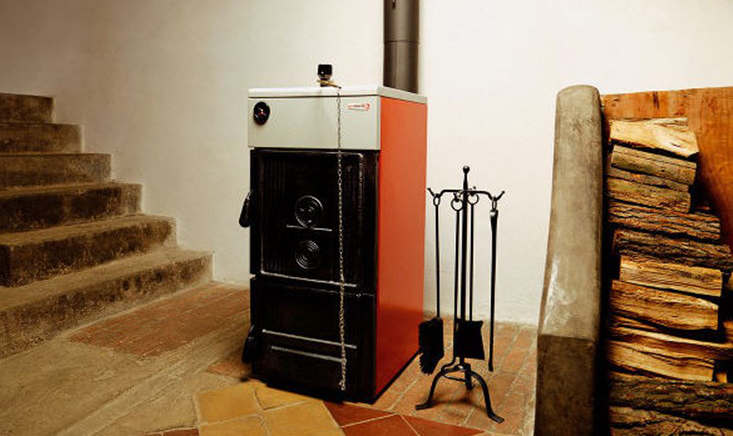

Kindling is needed every 3-4 hours.
Let's sum up the sad results
The results of our comparison are disappointing. The available options for heating a country house without gas make us choose between an empty wallet and sleepless nights spent firing up the boiler.
Is the situation absolutely hopeless?
Electric heating
This type of boilers can be used as the main and additional heat source.
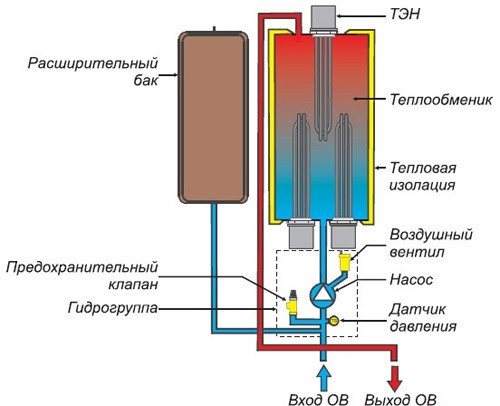

The principle of operation of an electric boiler
Benefits:
- Small dimensions;
- High efficiency;
- Lack of flame;
- Possibility of connecting boilers and using the "warm floor" technology;
- High reliability of installations;
- Environmental friendliness, no chimney;
- No need for constant maintenance.
The disadvantages include high energy consumption, which means the high cost of heating.
Autonomous heating (gas holder)
It is the best option for small or country houses where they do not live permanently. The device allows you to get heat, hot water and electricity.
It is a large container containing liquefied gas (butane, methane, their various mixtures). The volume of the vessel is chosen in such a way that it will last for one season.
There are two types of structures:
- Vertical. They have a small evaporation area. Often several tanks are installed in parallel to increase the evaporation surface.
- Horizontal. Requires more installation space.
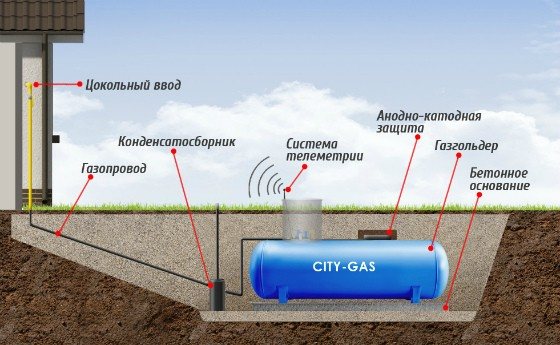

Horizontal gas tank underground
Device
The tank body is made of high-carbon steel or reinforced concrete, which can cope with heavy loads and high pressure of the gas mixture. A layer of anti-corrosion coating must be applied to the surface.Modern models are manufactured on a constant volume with instrumentation and control devices that allow continuous monitoring of gas pressure. A condensate trap is located at the bottom of the housing, in which the liquid formed during the evaporation of gases is collected.
The container should be placed on concrete slabs away from structures and buildings (at least 10 m) above the ground or in a pit. In the northern regions, only hidden installation of vessels is allowed. In addition, in this case, there is no need to additionally install devices for heating and gas evaporation.
Disadvantages:
- Fuel storage;
- High installation costs;
- A small number of companies serving this heating equipment;
- High safety requirements;
- Large dimensions.
- The use of small cylinders is extremely inconvenient due to the need to constantly refuel them.
Operating principle
Similar to conventional gas boilers. Differences - a different type of fuel and a specific layout of the pipeline. When liquefied gas is burned, the mixture enters the reactor, maintaining the operating pressure in the system, after which it is distributed through the pipelines of the heating system.
Refueling of the tank should be carried out once a heating season, therefore, the volume of the tank must be calculated based on the area of the heated rooms.
Important! Mobile models (up to 500 liters) with a built-in heating system are widespread.
Traditional oven
Despite the fact that a traditional stove heats up for a very long time, it also retains heat in the house for a long time.
The traditional Russian-style stove with a stove bench has long lost its popularity. However, many homeowners opt for a more modified stove that heats the home perfectly. Now it is not so easy to make it yourself and with high quality, so you may have difficulties. A brick oven is the best option for heating a country house.
To make such a stove, it is worth using the services of master stove makers. If they do their job at a high level, then even the most severe frost will be of no concern to you. But in order to keep warm in such a house as long as possible, it is necessary to insulate the walls and windows.
Thanks to such a stove, it will be possible to spend the night and live in the house, since all the conditions will be created for this. Some models of traditional stoves are equipped with hobs. However, not everyone can cook on such a stove, since it requires adjusting the strength of the fire. Also, it is necessary to use special dishes here.
Geothermal systems
Gaining great popularity through the use of energy from natural resources. The heat from the bowels of the earth heats objects. In geothermal systems, this energy heats up heat exchangers, from which, using a heat pump, the working fluid enters the heating pipelines.
These heating systems can generate 4-6 times more energy than the applied one: for 1 kW of electricity, it is possible to generate heat up to 6 kW.
Benefits:
- Providing heat and electricity in remote regions;
- Independent adjustment of the parameters of the heating network and the flow rate of the heating agent;
- Low heating costs;
- The possibility of increasing thermal and electrical loads without the permission of housing and communal organizations;
- Environmental friendliness and safety;
- Lack of labor costs for the delivery of fuel resources;
- Ease of fuel storage;
- The ability to install yourself;
- Long service life.
But there are, of course, disadvantages:
- Long payback;
- As a rule, it is considered as an additional source of heating.
Device and principle of operation
There is a heat exchanger in the ground shaft; a heat pump is installed on top, which heats the liquid and lifts it into the heating system.
Geothermal heating consists of two parts - one located in the house, the other in the ground.
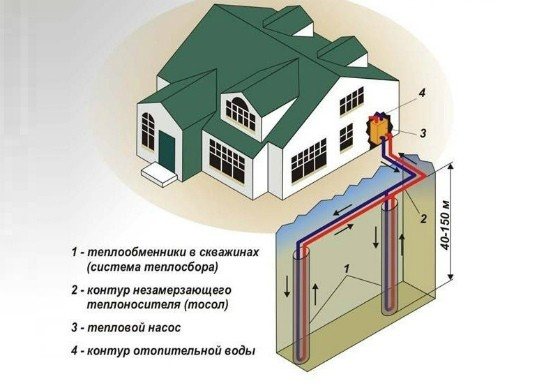

Geothermal system is a good alternative to gas heating in a private house
The ground part is identical to the classic hot water heating - pipes and radiators. Also in the house, you need to choose a place to install a generator that converts the energy of the earth into heat. As a rule, this is a basement or a free-standing room. Self-installation of the system is done as follows:
- The mine is the first to be built. The parameters (width and depth) are selected individually for each case. Depends on the climate, the type of soil, the output power of the heating equipment, the area of the house;
- Then comes the installation of heat exchangers and pipes at the bottom of the mine, through which the coolant will flow to the radiators of the house.
In the summer, this system can be used for air conditioning. When additional equipment is installed, the cooled heat carrier will be supplied from the heat exchanger to the system.
The underground part provides for the creation of a well and a heat exchanger.
There are three types of geothermal heating:
- Powered by water from a nearby reservoir. At the bottom, probes are installed that convert the thermal energy of the water;
- Deep groundwater energy. The heat pump lifts the groundwater, which gives off heat and energy to the home heating system;
- Heating with antifreeze. In this case, an earthen mine is built, at least 75 m deep. When heated by a heat pump, the coolant enters the heat exchanger. After taking in the heat, the antifreeze is lowered back into the mine.
solar collector
A solar collector is a device that converts solar energy into thermal energy. Reviews of this device once again prove the effectiveness of the system. After the sun's energy is transformed into heat, it is transferred to the coolant. Now the direct rays of the sun can be used both for heating the room and for heating the water.
During one year of use of the solar collector, the consumption remains at the same level. That is why the use of such a unit can be made for quite a long time.
With the correct installation of the solar collector, the water temperature can be between 50 and 65 degrees. And in the summer months, when the sun is especially close to the ground, heating can be done up to 100 degrees.
The basis of the solar installation - flat collector. It contains an absorber that can absorb the rays of the sun, converting them into thermal energy. To reduce thermal losses, the collector is placed in a thermally insulated box with transparent walls.
Heating by solar energy
This type is gaining popularity due to the free heat source - the sun. It is used as an additional heating and power supply system. With the construction of complex systems and the presence of storage batteries, it is possible to obtain an absolutely autonomous heat source.
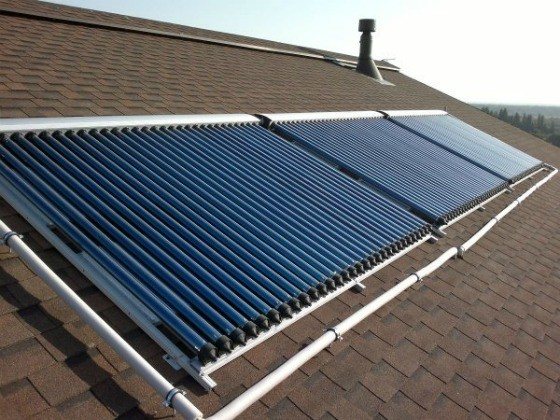

Vacuum solar collectors for home heating
Solar installations
Using solar energy to heat a house is a promising, but still little used method of heating a house without gas and electricity.
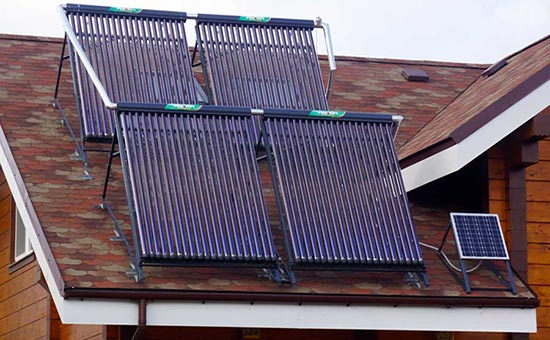

First, with the help of solar power plants, you can provide such a house with electricity, using solar panels for this. If the area of the batteries is quite large, then the resulting electricity can be used to heat the house. The main disadvantage of this option is the high cost of high-power solar panels.
Secondly, solar air or liquid collectors can be used directly to heat the house. True, in this case, it will not be possible to do without electricity at all: for heating with the help of an air collector, the operation of a fan is needed, and to use a liquid solar collector for heating, the operation of a circulation pump is needed. Liquid solar plants with natural circulation of the heating medium are mainly used for hot water supply. In order to use such installations for heating a house at low temperatures, they must be double-circuit, using antifreeze liquid in the first circuit and an indirect heating boiler.The cost of such equipment is quite high.
At present, this type of heating can be considered as additional, and even then in areas with a sufficiently high solar activity.
More about solar plants
conclusions
Geothermal heating systems are an excellent alternative to classic heating systems, because the energy of nature is renewable and environmentally friendly. The only drawback is the small number of specialized maintenance services. Even with a high initial cost (installation and purchase of equipment), the systems pay off in several seasons.
Small gas tanks are the best solution for small cottages and country houses.
The maximum effect and minimum heat loss when using any type of heating are observed in the complex insulation of buildings - wall cladding, floor insulation, high-quality double-glazed windows.

